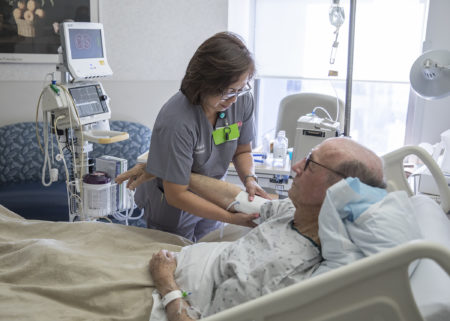How Cedars-Sinai Health System is navigating shortages during the global supply chain crisis
Back

With unprecedented global supply chain challenges, any organization reliant on products and supplies has felt the impact over the last several months. These challenges have further affected healthcare providers already battered by 20 months of the COVID-19 pandemic. Supply lines are stretched thin for critical PPE, and healthcare providers face a much more ominous threat as the global supply chain logjam extends much deeper into the medical supply portfolio, affecting thousands of items. To respond to these challenges, Cedars-Sinai has developed several key approaches, including innovative predictive analytic models. These innovations have enabled Cedars-Sinai to continue supporting every patient in every setting.
More than 40% of the U.S. inbound freight flows into the ports of Long Beach and Los Angeles. As a result, thousands of medical supplies are mixed with millions of other products destined to U.S.- based factories, warehouses and homes.
The impact of this logjam has led to shipping delays two-to-three times previous lead times, with similar delays once products reach ports. Further delays are exacerbated by strained rail and trucking capacity as well as bottlenecks at warehouses throughout the country. Unfortunately, most projections forecast a worsening situation that may last another 18 months. Medical suppliers have implemented several mitigating actions both from a manufacturing footprint perspective as well as from a domestic logistics lens. Many have diversified their sourcing portfolio to include more production from North America, Europe and other locations that can be imported through less congested ports. Logistically, ships have been rerouted, air transport has been leveraged, and product shipments from warehouses outside the local demand radius are now used more frequently.
But it’s not enough. Healthcare providers have seen lead times increase by 15-20% in the last two months. The number of items not delivered on any given day has more than tripled. For every bed in a hospital, staff must replenish about four to five unique items per day. A hospital with 1,000 beds places about 5,000 orders per day to support patient care. With an ideal fill rate of 98% (meaning you receive 98% of what you ordered), it is expected that roughly 100 items will not be delivered on any given day. Current fill rates are in the low 90% range.
Healthcare systems are struggling to obtain products like needles, syringes, blood tubes, catheters, and nitrile gloves—with a growing list by the day. COVID-19 has accelerated the focus on supply chain value and clinical integration. Unable to rely solely on their supply base, Cedars-Sinai dramatically evolved internal capabilities and external interoperability to secure continued supplies for patients.
Several supply chain risk solutions have been on the market for years, and the healthcare sector has seen some of these companies pivot to address medical supplies. But none address the immediate needs to secure the product. Hence, Cedars-Sinai is taking internal and external actions to mitigate risk and protect patients. Tactical shortage reviews, in collaboration with key suppliers, have become the norm. These are daily, data-driven meetings where every product that was shorted is reviewed and either sourced through alternate channels or substituted with clinically approved alternates. Leadership escalation meetings are part of the landscape and facilitate both strategic problem solving and tactical prioritization.
Internally, organizations are increasing inventory levels, re-energizing clinical tiger teams, and seeking alternate care pathways in critical supply shortage situations. It is incumbent on supply chain teams to prioritize conversations on the most critical items. But how does one sift through a portfolio of more than 15,000 medical supplies to find the critical few that need action? Cedars-Sinai is leveraging advanced analytics to project and focus on critical product risks.
Supply chain modeling techniques, coupled with predictive analytics, provide an array of options to quickly and dynamically identify items that need to be addressed. Starting with sensitivity analysis and heuristics, items are filtered to those exhibiting declining fill rates. Items are then filtered based on categories deemed critical to patient care by a cross functional team, including clinicians and supply chain representatives. Next, items go through a manual check to help finalize the immediate list to be sourced and procured to maintain supply assurance. This process is repeated weekly to account for fluctuations in delivery failure rates. A secondary, more forward-looking model utilizes procedure (future) schedules coupled with historical run rates and associated supply utilization to forecast item demand and approximate risk envelope. This data is then fed through the same filtering methodology described earlier to identify critical items for action.
The continuing challenges in the healthcare supply chain have led to innovative solutions rarely seen in this sector. Warehouses that were once considered capital liabilities have now become strategic assets. Supplier and cross-community hospital partnerships, now recognized as essential elements of our ecosystem, are driving a transformation in how healthcare supply chains should evolve. City, state, and federal governments have all leaned in to better understand and support the challenges faced by our industry. While mid-term projections point to continuing challenges, cross-functional collaborative models, supported by predictive analytics, suggest that existing mitigation strategies will continue to minimize risk and ensure timely and effective medical care. As healthcare professionals, Cedars-Sinai recognizes that at the end of every supply chain awaits a patient—and that individual is our number-one priority.
